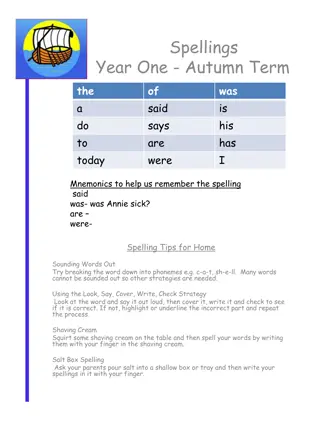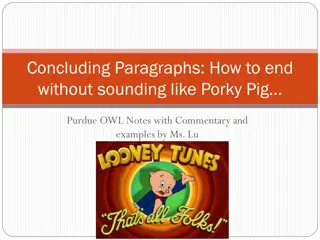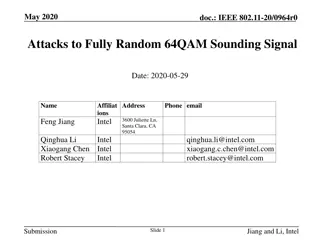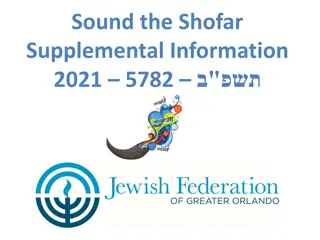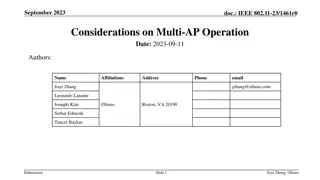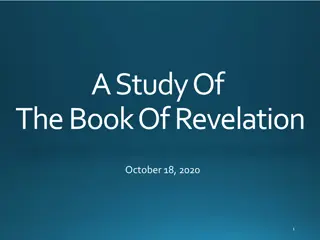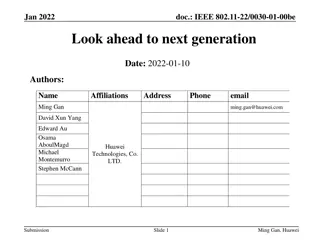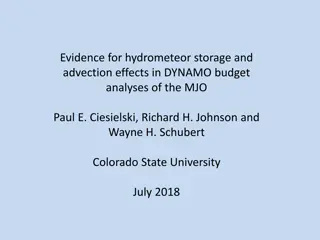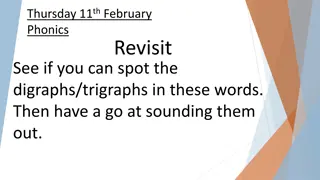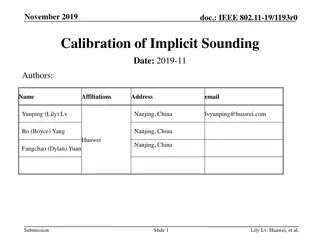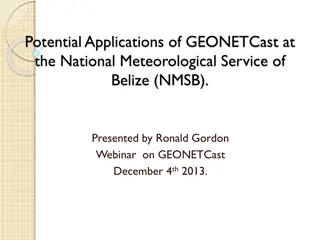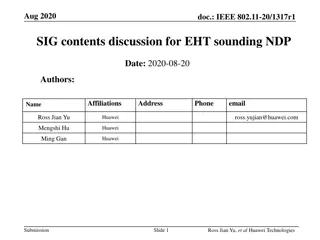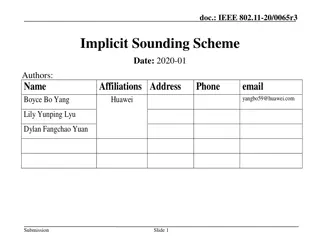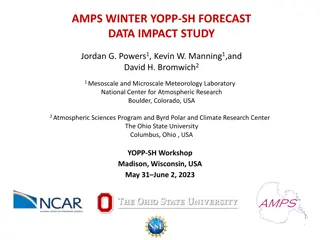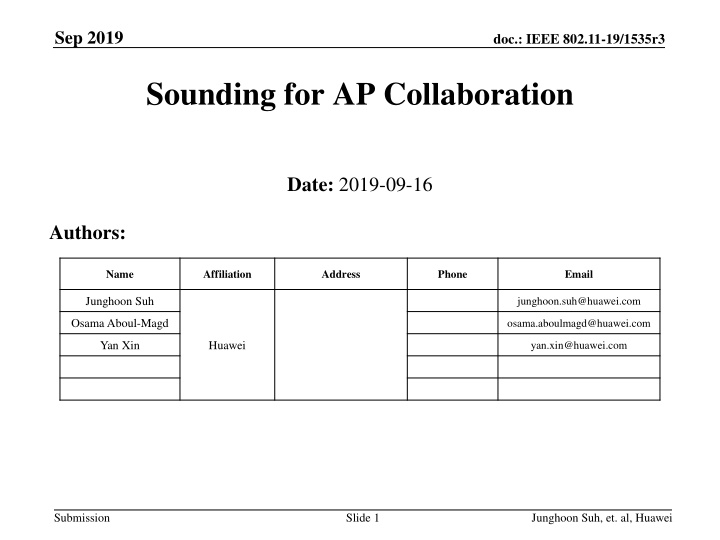
Enhancing AP Collaboration with Sounding Procedures - IEEE 802.11-19/1535r3
Explore the detailed description of the NDPA/NDP transmission protocol for AP collaboration in IEEE 802.11-19/1535r3. Learn about the benefits and challenges of sequential versus simultaneous sounding packet transmission from multiple APs to STAs. Discover how to compute CBF and JT pre-coders using a serial sounding and concurrent sounding method, along with issues and solutions related to channel reconstruction and Eigen values in APs.
Download Presentation

Please find below an Image/Link to download the presentation.
The content on the website is provided AS IS for your information and personal use only. It may not be sold, licensed, or shared on other websites without obtaining consent from the author. If you encounter any issues during the download, it is possible that the publisher has removed the file from their server.
You are allowed to download the files provided on this website for personal or commercial use, subject to the condition that they are used lawfully. All files are the property of their respective owners.
The content on the website is provided AS IS for your information and personal use only. It may not be sold, licensed, or shared on other websites without obtaining consent from the author.
E N D
Presentation Transcript
Sep 2019 doc.: IEEE 802.11-19/1535r3 Sounding for AP Collaboration Date: 2019-09-16 Authors: Name Affiliation Address Phone Email Junghoon Suh junghoon.suh@huawei.com Osama Aboul-Magd osama.aboulmagd@huawei.com Yan Xin Huawei yan.xin@huawei.com Submission Slide 1 Junghoon Suh, et. al, Huawei
Sep 2019 doc.: IEEE 802.11-19/1535r3 Background [1] proposed several options of sounding procedures for the AP collaboration scenario, and we want to describe the NDPA/NDP transmission protocol in further detail in this contribution Sounding packets are sequentially transmitted from each AP towards STAs, the sounding overhead increases in proportion to the number of APs in collaboration in this case, however the computation burden on the CSI is not relatively heavy When the sounding packets are simultaneously transmitted from the APs in collaboration, the sounding protocol overhead is reduced but all the CSI computation burden is transferred to the STA side Submission Slide 2 Junghoon Suh, et. al, Huawei
Sep 2019 doc.: IEEE 802.11-19/1535r3 Serial Sounding Packet Transmission [1][2] Master AP can send an NDPA, followed by NDP1 and the Slave APs will send NDPs towards STAs one by one serially and/or respectively NDPA may need an indication of EHT NDPA type. Trigger* NDPA Master AP NDP1 Slave AP1 NDP2 Slave AP2 NDP3 STA 1 . STA N * This Trigger frame is to collect the BF Report from STAs Submission Slide 3 Junghoon Suh, et. al, Huawei
Sep 2019 doc.: IEEE 802.11-19/1535r3 How to compute CBF and JT Pre-coders from Serial Sounding and Concurrent sounding of method (2) TX 1 RX 1 ??1??1 11 Aggregated Channel reconstructed at APs . RX M1 11 12 TX N1 AP1 K1 . STA 1 ??1??1 ??2??1 ??1??2 ??2??2 ZFBF 21 22 RX 1 TX 1 Precoding Matrix across APs in collaboration . RX M2 11 12 TX N2 ??1??1 ??2??1 ??1??2 ??2??2 STA 2 . K2 AP2 22 ??2??2 21 22 CBF JT Top K1Streams of outputs are transmitted from AP1 Top K1Streams of outputs are transmitted from AP1 d1 d1 11 12 ???1 ??1??1 ??2??1 ??1??2 ??2??2 ??1??1 0 0 dK1 s1 sK2 dK1 s1 sK2 21 22 ???2 ??2??2 BottomK2Streams of outputs are transmitted from AP2 Bottom K2Streams of outputs are transmitted from AP2 PCBF1is obtained with Pseudo-Inverse of H11 and H21and taking the 1st K1 columns, while PCBF2 can be computed with Pseudo-Inverse of H12 and H22and taking the last K2 columns. Submission Slide 4 Junghoon Suh, et. al, Huawei
Sep 2019 doc.: IEEE 802.11-19/1535r3 Issues and Solution for a Serial Sounding and Concurrent Sounding method (2) Channel can be reconstructed in AP side based on the Eigen values and Right Eigen matrix, that is, when the channel H is Singular-Value-Decomposed, it is USVH, and only the S and V are fed back according to the 802.11 CSI Report. U is just the unitary matrix with the phase information which can be ignored in the Precoder computation When Channels are aggregated on top of each other, the U, S, and VH can also be aggregated respectively, and thus, the aggregated U can be ignored as well like the single H case. However, when the channel aggregation takes place side by side like ??1??1 previous slide, we cannot ignore the U of each channel Since ZFBF precoder for CBF or a single AP based DL MU-MIMO can be computed from the aggregated channel on top of each other channel, U can be ignored but U cannot be ignored for the JT precoder computation 11 12 and ??1??2 in the Solution for this problem for the case of multi AP based JT, the channels between each STA and all those APs in collaboration shall be aggregated in each STA first before taking the SVD and calculate the CSI information. Submission Slide 5 Junghoon Suh, et. al, Huawei
Sep 2019 doc.: IEEE 802.11-19/1535r3 Continued for the Issues and Solution for a Serial Sounding and Concurrent Sounding method (2) ??=?? ???? ??=?? ??? ? Type A aggregation: Single AP DL MU-MIMO and Multi AP CBF require this type A aggregation ??? ?? ???? ??? ?????=?? ?? 0 0 ? 0 0 ? = ? ? ?? ?? ????? can be used for Precoder computation Type B aggregation: Multi AP JT requires this type B aggregation as well as type A aggregation ?????= ?? ??= ?? ???? ?? ??? Solution ?????= ????? ????????? ???? and ?????are fed back as CSI information AP which receives this CSI info may re-construct the ????? based on ???? and ????? to compute Precoder ? ???? ? ??? ? Submission Slide 6 Junghoon Suh, et. al, Huawei
Sep 2019 doc.: IEEE 802.11-19/1535r3 Concurrent Sounding Packet Transmission [2][3] Master AP can send an NDPA, and both Master and Slave APs will send simultaneous NDP towards STAs immediately following the NDPA (Scheme A) Sounding Trigger may allow both Master AP and Slave AP to transmit NDPA simultaneously, followed by the concurrent NDP frames from both APs (Scheme B) NDPA may need an indication of EHT NDPA type Scheme B Scheme A Sounding Trigger Trigger* Trigger* NDPA NDPA Master AP NDP1 NDP1 Slave AP NDPA NDP2 NDP2 STA 1 . STA N * This Trigger frame is to collect the BF Report from STAs Submission Slide 7 Junghoon Suh, et. al, Huawei
Sep 2019 doc.: IEEE 802.11-19/1535r3 Realization of Simultaneous NDP Transmission (1) NDP may include the EHT-SIG field and indicate the global number of TX antennas across all APs in collaboration The number of LTFs in each NDP transmitted from each individual AP depends on the global number of TX antennas E.g.) Global TX across all APs in collaboration is 8, then the number of LTFs is 8 in each NDP However, only the subset of P-matrix will be applied to each AP for the transmission of its respective NDP, that is, the subset of rows in P-matrix corresponding to its respective number of TX will be applied in each individual AP E.g.) 2 AP collaboration, each with 4 TX antennas global 8 TX antennas For each NDP, ???1? ???2? ???7? ???8? (?)?4?8?? 4?8=???? 1 1 1 1 1 1 1 1 1 1 P4X8 = [P4X4 P4X4] for Master AP, P4X8 = [P4X4 -P4X4] for Slave AP, where ?4?4= 1 1 1 1 1 1 (k ) sk is an LTS in subcarrier k, and is a diagonal CDD mapping matrix CDD D Submission Slide 8 Junghoon Suh, et. al, Huawei
Sep 2019 doc.: IEEE 802.11-19/1535r3 Realization of Simultaneous NDP Transmission (2) Sub-carrier interleaved LTF between APs in collaboration can also be used to realize the concurrent NDP transmission from APs in collaboration Sub-carriers of LTFs are alternately occupied by the LTS of each AP Drawback is the minimum Ng size is determined by the number of APs in collaboration Number of LTFs is determined by the largest number of TX in any AP of APs in collaboration We need to indicate the actual number of TX antennas for each AP in collaboration in the EHT-SIG field of NDP frame or in the NDPA NDPA or EHT-SIG field of NDP needs to indicate the number of APs in collaboration, as well . Sub-carriers in one of the sub-carrier interleaved LTF symbols in case of 4 AP Collaboration : Long Training Sequence (LTS) from Master AP : Long Training Sequence (LTS) from Slave AP1 : Long Training Sequence (LTS) from Slave AP2 : Long Training Sequence (LTS) from Slave AP3 Submission Slide 9 Junghoon Suh, et. al, Huawei
Sep 2019 doc.: IEEE 802.11-19/1535r3 How to compute CBF and JT Pre-coders from Concurrent Sounding, Realization Method (1) TX 1 RX 1 Aggregated Channel reconstructed at APs ??1?(?1+?2) ??2?(?1+?2) . 1 ??1?(?1+?2) RX M1 1 TX N1 AP1 K1 . STA 1 2 2 ??2?(?1+?2) RX 1 TX 1 ZFBF Precoding Matrix across APs in collaboration . RX M2 TX N2 P STA 2 . K2 AP2 (?1+?2)X(?1+?2) CBF JT Top K1Streams of outputs are transmitted from AP1 Top K1Streams of outputs are transmitted from AP1 d1 d1 ???1 P ??1??1 0 0 dK1 s1 sK2 dK1 s1 sK2 (?1+?2)X(?1+?2) ???2 ??2??2 BottomK2Streams of outputs are transmitted from AP2 Bottom K2Streams of outputs are transmitted from AP2 The channel between each STA and each AP is separated from the fed-back CSI info, and then newly aggregate the channels between each AP and the CB scheduled STAs. And then, the same procedure as in slide 4 can be taken for the CBF precoder. Submission Slide 10 Junghoon Suh, et. al, Huawei
Sep 2019 doc.: IEEE 802.11-19/1535r3 Comparisons for NDP transmission procedures Pros Cons Serial NDP Transmission - - CSI computation is limited to one AP at a time Avoid the indication in NDPA such as global TX antennas and/or Number of APs in collaboration EHT-SIG field can be used instead for any possible indication (e.g. BSS color) - Protocol overhead is proportional to the number of APs in collaboration - CSI computational burden becomes high as the MIMO size increases with the global TX - *Global TX can be limited to 16 - Concurrent NDP Transmission (1) - - Protocol overhead is reduced Minimize the indications in NDPA except for global number of TX across APs in collaboration EHT-SIG field of NDP can be used for the indication of global number of TX Incumbent 802.11 based implementation, relatively simple - CSI computational burden becomes high as the MIMO size increases with the global TX - *Global TX can be limited to 16 - - Concurrent NDP Transmission (2) - Protocol overhead is reduced - EHT-SIG field of NDP can be used only for the common information of APs in collaboration - Number of TX antennas of each AP in collaboration can be indicated only in NDPA - CSI computational burden becomes high as the MIMO size increases with the global TX - *Global TX can be limited to 16 Submission Slide 11 Junghoon Suh, et. al, Huawei
Sep 2019 doc.: IEEE 802.11-19/1535r3 Summary We compared the Serial NDP Transmission and Concurrent NDP Transmission For the JT schedule, the channels between each STA and all the APs in collaboration need to be aggregated in each STA before computing the CSI information The global number of TX across collaborative APs is limited to 16, so the APs can choose to transmit the NDP sounding multiple times in case the global TX is more than 16. Both Serial and Concurrent NDP transmission are recommended to be available in EHT, so APs can choose the sounding method according to the scheduling situation Submission Slide 12 Junghoon Suh, et. al, Huawei
Sep 2019 doc.: IEEE 802.11-19/1535r3 Reference [1] Ross Jian Yu et. al., 11-19/1097r0 Sounding Procedure in AP Collaboration , July 2019 [2] Kosuke Aio et. al., 11-19/1134r1 Consideration of Multi AP Sounding , Aug 2019 [3] Sudhir Srinivasa et. al., 11-19/1094r0 Joint BF Simulations , Aug 2019 [4] Sudhir Srinivasa et. al., 11-18/1510r1 AP Coordinated Beamforming for EHT , Sep 2018 Submission Slide 13 Junghoon Suh, et. al, Huawei
Sep 2019 doc.: IEEE 802.11-19/1535r3 SP 1 For the AP collaboration sounding, do you agree to include the Joint NDP transmission? Including the Serial Sounding based on slide 3 is TBD How and when to apply the Serial sounding and Joint Sounding, TBD Y/N/A Submission Slide 14 Junghoon Suh, et. al, Huawei
Sep 2019 doc.: IEEE 802.11-19/1535r3 SP 1-b For the multi AP system, do you agree to support the Joint sounding? Y/N/A Submission Slide 15 Junghoon Suh, et. al, Huawei
Sep 2019 doc.: IEEE 802.11-19/1535r3 SP 2 For the Concurrent NDP transmission, which realization of concurrent NDP transmission do you prefer? Option 1: P-matrix based one such as Concurrent NDP Realization (1) Option 2: Sub-carrier interleaved LTF based one such as Concurrent NDP Realization (2) Submission Slide 16 Junghoon Suh, et. al, Huawei
Sep 2019 doc.: IEEE 802.11-19/1535r3 SP 3 For the Joint Transmission, do you agree that each STA needs to aggregate the estimated channels with all the APs in collaboration before the CSI computation, and feedback the CSI information for the aggregated channel? That is, for JT, each STA shall compute the CSI information for the aggregated channel with the size of ???? x ???, where ???? is the global number of TX across all participating APs for collaboration, and ??? is the number of RX at the individual STA which computes the CSI information. Submission Slide 17 Junghoon Suh, et. al, Huawei
Sep 2019 doc.: IEEE 802.11-19/1535r3 Appendix PER of Scheduled STAs for CBF and JT Concurrent Sounding based on P-matrix based method (1) PER of Scheduled STAs for CBF and JT Serial Sounding, Individual CSI feedback between a STA and an AP PER of Scheduled STAs for JT Serial Sounding, Individual full Channel feedback between a STA and an AP PER of Scheduled STAs for JT Serial Sounding, Aggregated CSI feedback between a STA and APs in Collaboration Submission Slide 18 Junghoon Suh, et. al, Huawei
Sep 2019 doc.: IEEE 802.11-19/1535r3 Common Simulation Parameters Zero-forcing BF for JT and CBF in the TX as in slide 4 or slide 7 ZFBF for all the Channels between APs and STAs in case of JT ZFBF for all the channels in each AP with all the STAs (including the STAs scheduled from coordinated APs) in case of CBF MMSE detection in each STA BCC for FEC, MCS 1 and 7, and Perfect Sync Packet size for PER: 400 bytes for MCS 1 and 500 bytes for MCS 7 TGnD Channel Submission Slide 19 Junghoon Suh, et. al, Huawei
Sep 2019 doc.: IEEE 802.11-19/1535r3 Coordinated BF TX 1 RX 1 11 ??1??1 . RX M1 TX N1 AP1 K1 . STA 1 RX 1 TX 1 . RX M2 TX N2 STA 2 . K2 AP2 22 ??2??2 K1= K2=2 M1= M2=2 N1= N2=4 There are 2 APs and 2 STAs STA1 is scheduled with AP1, and STA2 is scheduled with AP2 These two STAs are selected among 4 STAs total, and the selected 2 STAs supposed to be scheduled with each AP, respectively. Submission Slide 20 Junghoon Suh, et. al, Huawei
Sep 2019 doc.: IEEE 802.11-19/1535r3 Joint Transmission TX 1 K1= K2=4 M1= M2=2 N1= N2=4 There are 2 APs and 4 STAs STA1 and STA2 are scheduled with AP1, and STA3 and STA4 are scheduled with AP2 K1 streams of data and K2 streams of data shall be shared across the AP1 and AP2 . TX N1 AP1 K1 TX 1 . TX N2 K2 AP2 Submission Slide 21 Junghoon Suh, et. al, Huawei
Sep 2019 doc.: IEEE 802.11-19/1535r3 Concurrent Sounding based on Realization method (1) Submission Slide 22 Junghoon Suh, et. al, Huawei
Sep 2019 doc.: IEEE 802.11-19/1535r3 Concurrent Sounding based on Realization method (1) Submission Slide 23 Junghoon Suh, et. al, Huawei
Sep 2019 doc.: IEEE 802.11-19/1535r3 CBF, Serial Sounding: Individual CSI feedback for the channel between an AP and a STA Submission Slide 24 Junghoon Suh, et. al, Huawei
Sep 2019 doc.: IEEE 802.11-19/1535r3 JT, Serial Sounding: Individual CSI feedback for the channel between an AP and a STA Submission Slide 25 Junghoon Suh, et. al, Huawei
Sep 2019 doc.: IEEE 802.11-19/1535r3 JT, Serial Sounding: Full Channel feedback for the channel between an AP and a STA Submission Slide 26 Junghoon Suh, et. al, Huawei
Sep 2019 doc.: IEEE 802.11-19/1535r3 JT, Serial Sounding: Aggregated CSI feedback for the channel between a STA and all APs in collaboration Submission Slide 27 Junghoon Suh, et. al, Huawei



